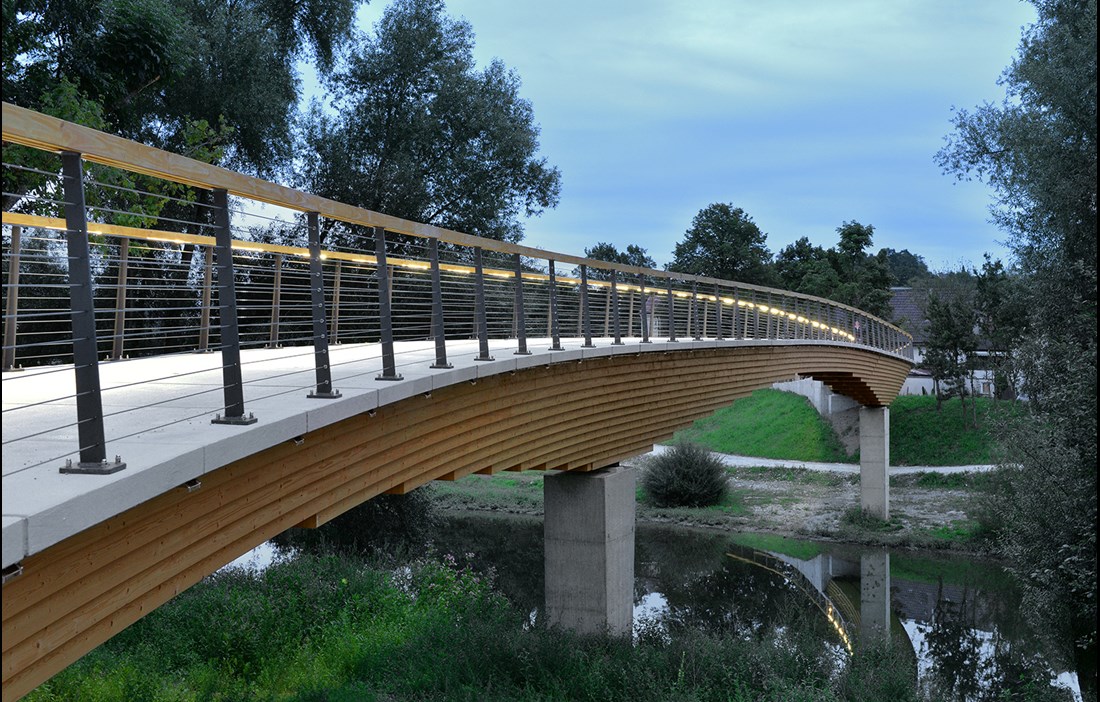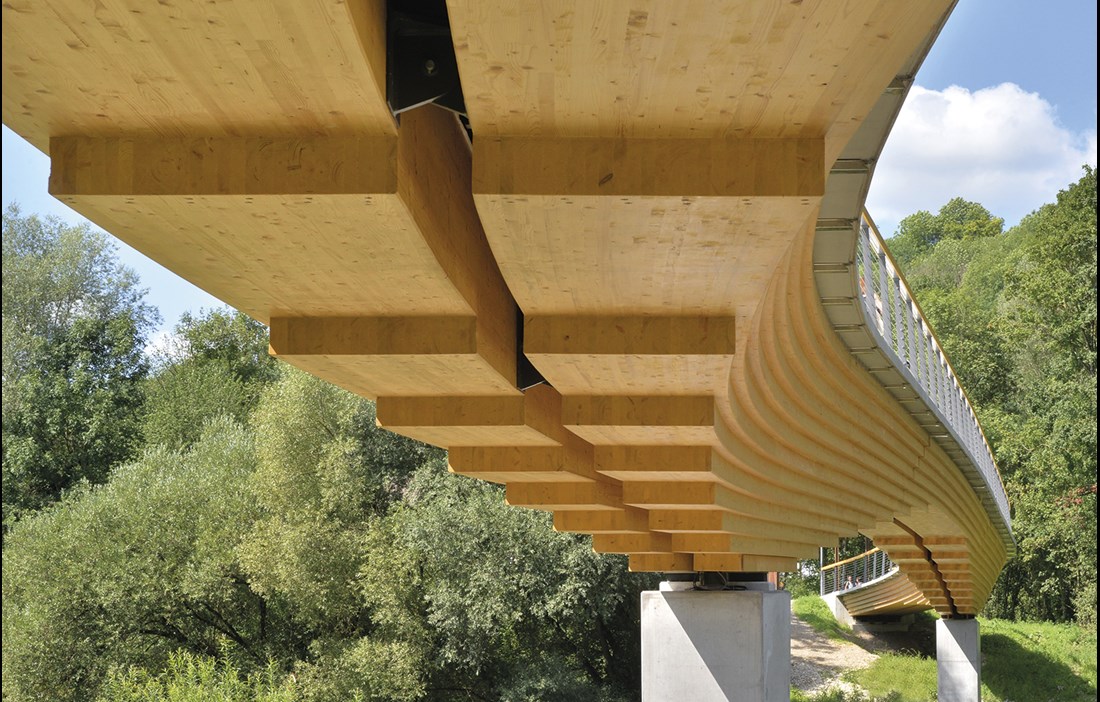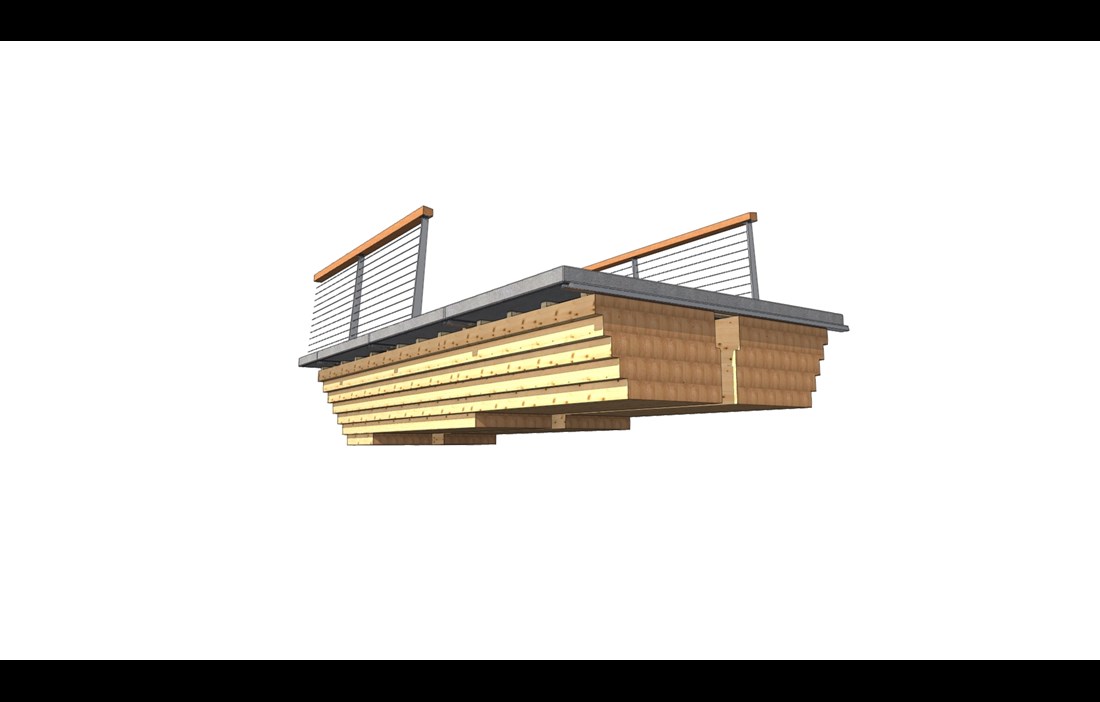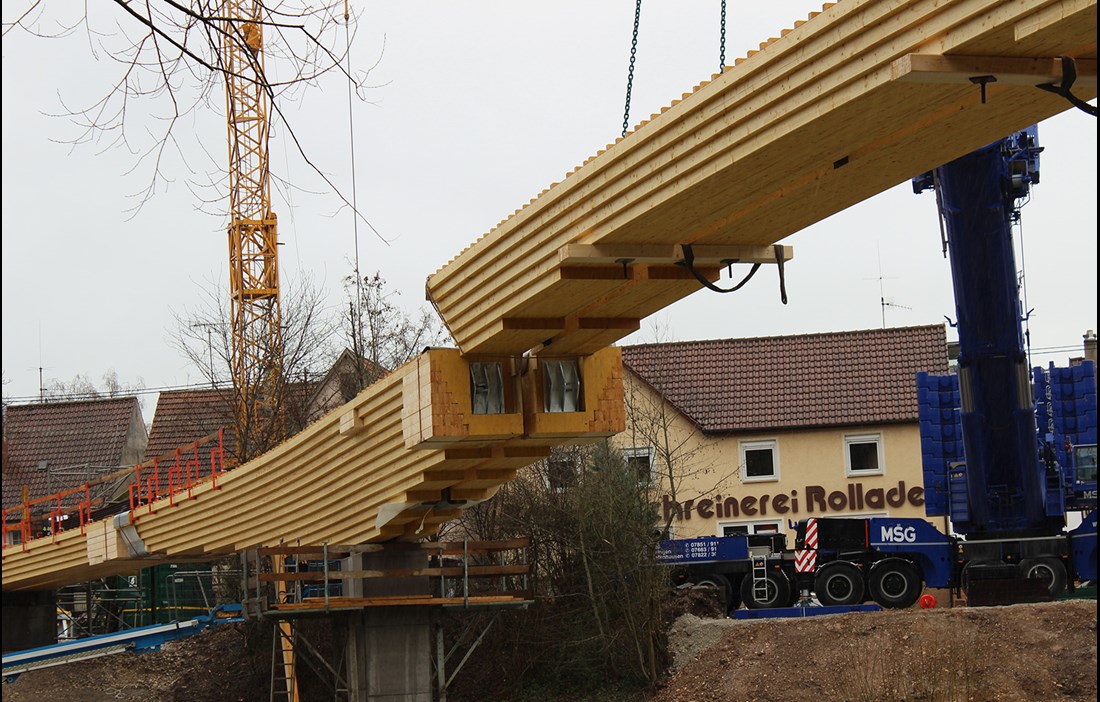The 362 kilometre River Neckar running through south-west Germany is traversed by almost 250 bridges, the latest of which is located in Neckartenzlingen. It is an elegant s-shaped wooden bridge that stretches 96 metres, allowing cyclists and pedestrian to cross from one side to the other.
The methods for building bridges have become increasingly sophisticated, and the character of bridges has changed from simple utilitarian objects to construction projects where artistic, technical, artisanal and environmental considerations are important parameters. A prime example is the new pedestrian and cycle bridge in the south-west German town of Neckartenzlingen, which was completed in spring 2017.
The area in the north of the Black Forest region is widely known for its beautiful cycle routes and attracts many visitors each year. Since the existing cycle path over the river was no longer big enough and led straight onto a busy road, a new bridge for cyclists and pedestrians had long been on the public wishlist in Neckartenzlingen. The primary goal was for the new bridge to follow the cycle route that runs through Neckardalen. At three metres wide, the new, vehicle-free bridge now offers ample space for those who want to walk or cycle over the Neckar.
Neckartenzlingen town council contacted engineering company Miebach, which specialises in modern wooden structures, with a particular focus on bridges. They produced a design for an s-shaped bridge that follows the cycle route on both sides of the river and fits in comfortably with the surrounding landscape.
“The town had initially been thinking about a traditional steel bridge, but we managed to convince them to go for wood instead by explaining the many advantages,” says Dominik Niewerth, who is a structural engineer and a specialist in wood technology at Miebach.
There were many reasons why the town council changed its mind. From a historical perspective, the town has a strong connection to wood. Ever since the 12th century, the River Neckar has been used to transport high quality logs from the Black Forest. Neckartenzlingen long served as a transshipment station for the wood on its journey to the Rhine and onwards to the shipbuilders on the Dutch coast. A wooden bridge is also better value, plus it is faster to prefabricate and erect. But it was the environmental considerations that really tipped the balance. Both the wood and the production facilities were available locally, for one thing. In addition, wood has less of an environmental impact than steel and concrete, not least because the 255 cubic metres of glulam used in the design are estimated to have captured around 207 tonnes of carbon dioxide.
“Wooden bridges are also ideal for pedestrian and cycle traffic. Their own weight is quite low compared with other bridges. For light traffic loads, they can therefore have a sleeker design than equivalent bridges in concrete, for example, where the weight of the material constitutes a large part of the overall load. With a narrow structure, the deformation criteria often determine the design of a wooden bridge,” continues Dominik Niewerth.
The bridge in Neckartenzlingen is a cantilever bridge, with the beams supporting the structure made from two parallel, block-glued and bent glulam components, joined by 12 beams stacked flat side to flat side and tapering inwards down the stack. The horizontal beams vary from 208 centimetres wide in the top layer to just 80 centimetres wide at the bottom. The bridge is constructed in three parts, with the middle one spanning an impressive 44.5 metres and the others 25.9 metres, giving the bridge an overall length of 96.3 metres. The split into three sections was the most practical in terms of transport and production, with the sections joined using what are known as Gerber joints on site. In addition to glulam, steel details have been used, as well as steel fixings to connect the wooden components of the bridge and join them to the two concrete piers, one on each side of the river.
“44.5 metres is considered an extremely long span for a wooden bridge of this kind,” states Dominik Niewerth, who also believes that the length of almost 100 metres makes it unique in Germany.
What sets the Neckartenzlingen bridge apart from many other wooden bridges is the carefully considered structural weatherproofing. The deck is made from prefabricated concrete slabs that have an overhang of 30 centimetres. This serves as a roof, effectively protecting the wooden structure from wind and weather. The bridge’s geometry, with the glulam beams gradually angling 30 degrees in beneath the bridge, helps to keep rain from reaching the structure itself. In addition, there are steel drainage channels fitted below the joints between the concrete slabs. As an extra precaution, the wood is also treated with a thin glaze to protect it against damp and air pollution. The cable railing is made from steel and stainless steel, with a handrail in acetylated glulam that has inset lighting.
Local wood engineering firm Schaffitzel Holzindustrie began manufacturing the bridge components in November 2016. In total, 255 cubic metres of locally produced timber was used for the glulam beams, which were engineered and joined in the factory. With the components all ready for assembly, in March 2017 they were lifted into place by two mobile cranes, one with a lifting capacity of 380 tonnes and one of 500 tonnes, which were positioned on each side of the river. The whole thing took just three days to assemble.
“Alongside the actual design, I’d like to highlight the competitive price, with the industrial process, fast assembly, long service life and low transport weight delivering economic benefits. As such, the price was on a par with what a steel structure would have cost, and much lower than for a concrete structure. The bridge was in place and ready for use a little over a year after we presented the first sketches in March 2016,” says Dominik Niewerth.
But perhaps the best thing of all is that the residents of Neckartenzlingen love their new bridge. It is well used by both cyclists and pedestrians and has quickly become a landmark for the town. In March 2018, the bridge won the public vote in the Holzproklima competition.
Text Katarina Brandt


























